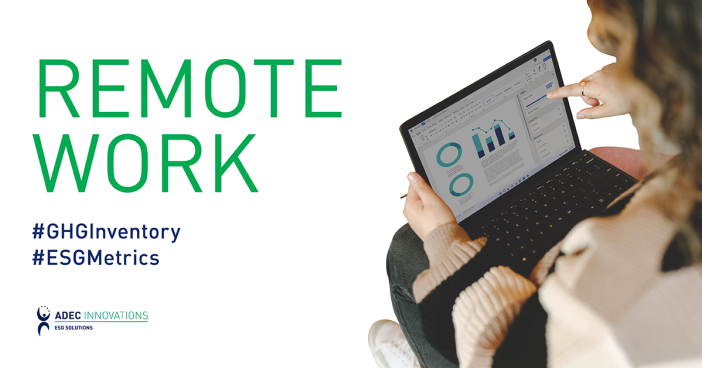Working from home has become a global trend in recent years as businesses adapt to the effects of the COVID-19 pandemic. Since 2020, an increasing number of employees have been working remotely from their homes. With fewer office buildings utilized as workplaces, there has been a decrease in commercial and industrial energy consumption and an increase in residential energy use, as reported by the International Energy Agency (IEA) in their 2020 Global Energy Report.
In turn, there is a growing need for companies to measure work-from-home emissions and include these metrics in their GHG reporting.
The GHG Protocol currently accounts for telework and remote working in Scope 3 Category 7: Employee Commuting. This category primarily includes emissions from transportation of employees between their homes and their worksites, but it also includes emissions from teleworking (i.e., employees working remotely).
Here, we look into the importance of measuring remote work emissions and how to calculate them.
Why measure remote work emissions?
With a significant shift to remote work setups, emission sources have also shifted—from office workspaces to employee homes. To ensure an accurate and comprehensive GHG inventory, these emissions must be accounted for in your company’s total carbon footprint. This is especially important if remote work comprises a significant portion of your company’s total carbon footprint, as accurate measurements will enable you to identify the environmental impacts of remote work and develop measures to manage it.
What to include in remote work emission calculations
Remote work emissions are emissions generated from equipment used by employees in performing work remotely. This includes electricity for lighting, computers, and other home office equipment. It also includes emissions from home heating and cooling, and it can also include emissions from home waste and recycling.
How to calculate remote work emissions
Currently, there is no concrete GHG reporting program guidance specific to remote work emissions. Although the GHG Protocol under Category 7: Employee Commuting does include these emissions, it does not provide a detailed discussion around accounting for remote work emissions. That said, in the U.S., there are various published methodologies that can help companies estimate remote work emissions.
To calculate emissions, begin by gathering usable and reliable data. Necessary parameters may include the following:
- Geography: Emission factors can be site-specific; thus, it is necessary to know the location where the emission occurs to be able to use emission factors appropriately.
- Equipment: Data on equipment type and corresponding energy usage that is directly attributed to remote work.
- Number of employees working remotely.
- Number of hours/days worked.
- Sources of estimates: In the absence of empirical data, you may need to perform an estimation (e.g. average household energy consumption, equipment load); thus, we recommend keeping track of the data sources you use to perform estimates.
1. Electricity
Emissions from electricity consumption can be estimated by multiplying:
Average U.S. household energy usage per day x Average working days per month x Number of employees working remotely x Corresponding electricity emission factor
Example:
Average household energy usage per day = 29.5 kWh = 0.0295 MWh
Days of remote work per month = 20
Number of employees working remotely = 50
Emission factor for electricity* = 818.3 lb CO2/MWh
tCO2 per month = 0.0295 MWh x 20 x 50 x 818.3 lb/MWh x 0.0005 ton/lb
tCO2 per month = 12.07
Another method of estimation focuses on power consumed by home equipment used specifically during working hours:
Average power consumed by computers, laptops, lighting, and other home office equipment x Average working hours per month x Number of employees working remotely x Corresponding electricity emission factor
Example:
Total combined wattage of home office equipment per employee = 2500 W = 0.0025 MW
Total remote working hours per month = 160 hours
Number of employees working remotely = 150
Emission factor electricity* = 818.3 lb CO2/MWh
tCO2 per month = 0.0025 MW x 160 hours x 150 x 818.3 lb/MWh x 0.0005 ton/lb
tCO2 per month = 24.5
2. Heating and Cooling
Emissions from heating and cooling can be calculated by estimating:
Amount of gas used to heat/cool an employee’s home for a month x Number of employees working remotely x Corresponding emission factor for natural gas
Example:
Amount of heating used by an employee per month = 800 kWh = 2.73 mmBTU
Number of employees working remotely = 150
Emission factor natural gas* = 53.06 kg CO2/mmBTU
tCO2 per month = 2.73 MMBTU x 150 x 53.06 kg/mmBTU x 0.001 ton/kg
tCO2 per month = 21.7
What’s next?
Once you have estimated your emissions from remote work, you’ll have a baseline which you can use to develop emission reduction targets. To achieve those targets, you may implement initiatives such as purchasing energy-efficient home office equipment and providing incentives to employees to engage them in energy-saving activities (e.g. to switch to LED bulbs, smart plugs).
As working from home becomes the new normal for many, we should expect emissions from remote work to increase in kind. You may see a reduction in emissions in your workplace, but these emissions are merely being generated in a different place, rather than being completely removed.
Going forward, it will be vital for organizations to accurately measure these types of less direct emissions, to ensure that all greenhouse gases are reported and reduction plans can be created to mitigate environmental impacts.
ADEC ESG Solutions is a leading provider of sustainability solutions, including fully-integrated industry expertise, software solutions, and data management. Visit us here to learn more about how our team can help you track and manage ESG data like GHG emissions, set targets, and integrate ESG into your strategy.




